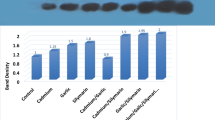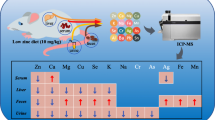Abstract
The effect of thiocetamide-induced liver cirrhosis on plasma and tissuemanganese levels and the protective role of selenium, zinc and allopurinolsupplements was investigated in rats. Control plasma and liver manganese(Mn) levels were found to be (mean ± SD): 8.4 ± 2.4 mg/L and5.7 ± 1.5 mg/g wet weight respectively. Plasma manganese levels weresignificantly increased (p < 0.001) whereas liver manganese levels weresignificantly reduced (p < 0.05) in the cirrhotic rats. Treatment withselenium, zinc and allopurinol reversed this trend and restored themanganese levels close to the normal values. Lung, spleen, and kidneymanganese levels under control conditions were considerably lower than thatof the liver tissue. However, these levels registered a significant increase(p < 0.05) in cirrhotic rats and this change was normalized after selenium,zinc and allopurinol treatment. There were no significant differences in thecomparative efficacy of each of these protective agents. Zinc supplementconsiderably increased the plasma zinc levels and plasma Zn/Mn ratio had agood correlation with plasma zinc concentration. This ratio wassignificantly reduced in cirrhotic rats, but returned to the control levelafter zinc, selenium and allopurinol treatment. The results of this studyindicate that the trace element, manganese, plays an important role instabilizing cell structure and that this effect is mediated possibly bypreserving the antioxidant activity of the tissues.
Similar content being viewed by others
References
Furst A: Trace elements related to specific chronic disease-cancer. In: HL Cannon and HC Hopps (eds). Environmental Geochemistry in Health and Disease, The Geological Society of America, Colarado, 1971, pp 109–130
Burch RE, Hahn HKJ, Sullivan JF: Other metals and the liver with particular reference to zinc. In: LW Powell (ed). Metals and the Liver. Marcel Dekker Inc., New York, 1978, pp 333–362
deRosa G, Keen CL, Leach RM, Hurley LS: Regulation of superoxide dismutase activity by dietary manganese. J Nutr 110, 795–804, 1980
Dreosti IE, Kecora IR, Buckey KM, Manuel ST, Frazer FJ: Ethanol and hepatic superoxide dismutase in rats. In: J McC Howell, JM Gawthorne and CL White (eds). Trace Element Metabolism in Man and Animals. Griffin Press Ltd., Netly, South Australia, 1981, pp 617–620
Keen CL, Tamura T, Lonnerdal B, Hurley LS, Halsted CH: Effects of chronic ethanol feeding on the activity of superoxide dismutase in monkeys. Am J Clin Nutr 35: 836, 1982
Behbehani A, Dashti H, Simsek M, Lari A, Al-Adnani MS: The role of zinc sulphate in normalizing superoxide dismutase activity in experimental liver cirrhosis. Sur Res Comm 11: 261–269, 1992
Dashti HM, Abul H, Behbehani A, Hussain T, Madda JP: Interleukin-8 and trace elements alterations in experimental liver cirrhosis. The J Trace Elem Exper Med 9: 27–40, 1996
Dashti H, Jeppsson B, Hagerstrant I et al.: Thiocetamide and carbon tetrachloride-induced liver cirrhosis. Eur Surg Res 21: 83–91, 1989
Hurley LS: Clinical and experimental aspects of manganese in nutrition. In: S Prasad (ed). Clinical, Biochemical and Nutritional Aspects of Trace Elements. Alan R Riss Inc., 150 Fifth Avenue, New York, NY 10011, 1982, pp 369–378
Okada A, Takagi Y, Nezu R, Sando K, Shankin A: Trace element metabolism in paranteral and enteral nutrition. Nutrition (supplement) 11(1): 106–113, 1995
Robenstein AH, Levin NW, Elliot GA: Manganese induced hypoglycaemia. Lancet ii: pp 1348–1351, 1962
Everson GJ, Shrader RE: Abnormal glucose tolerance in manganese deficient guinea pigs. J Nut 94: 89–94, 1968
Zidenber-Cherr S, Keen CL, Lonnerdal B, Hurley LS: Superoxide dismutase activity and lipid peroxidation in the rat: Developmental correlations affected by manganese deficiency. J Nutr 113: 2498–2504, 1983
Barak AJ, Beckenhauer HC, Kerrigan FJ: Zinc and manganese levels in serum and liver after alcohol feeding and development of fatty cirrhosis in rats. Gut 8: 454–457, 1974
Versieck J, Barbier F, Speecke A, Hoste J: Manganese, copper and zinc concentrations in serum and packed blood cells during acute hepatitis, and post-hepatitic cirrhosis. Clin Chem 20: 1141–1145, 1974
Alan Sehnkin: Trace elements and Inflammatory response: Implications for nutritional support. Nutrition (Supplement)11(1): 100–105, 1995
Zarski JP, Arnaud J, Dumorlad L, Favier A, Rachail M: Trace elements (zinc, copper, manganese) in alcoholic cirrhosis: Effect of chronic alcoholism. Gastroenterol Clin Biol 9(10): 664–669, 1985
Author information
Authors and Affiliations
Rights and permissions
About this article
Cite this article
Al-Bader, A., Dashti, H., Mosawi, M. et al. Effect of dietary selenium, zinc and allopurinol supplements on plasma and tissue manganese levels in rats with thiocetamide-induced liver cirrhosis. Mol Cell Biochem 173, 121–125 (1997). https://doi.org/10.1023/A:1006835912530
Issue Date:
DOI: https://doi.org/10.1023/A:1006835912530




